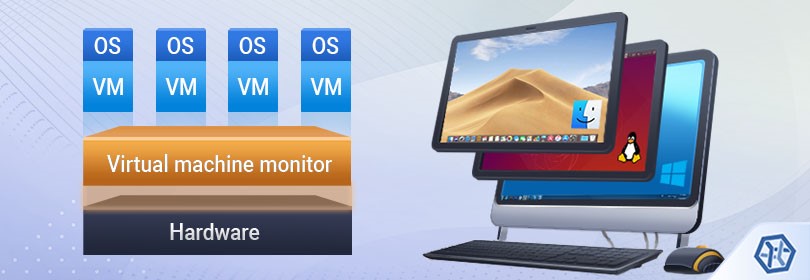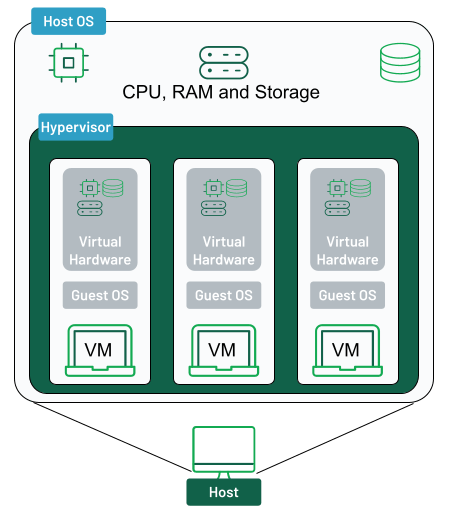
For personal use, virtualization enables users to run different operating systems(opens in on their home PC, such as running Windows on a Mac(, or running Linux on a Windows PC – and with all possible permutations in host and VM available
A main reason for running a virtual machine is that it enables you to run apps that would not otherwise run due to having very different system requirements, this is why virtualization has become essential to business.
Another,important benefit is that security issues such as malware(opens in new tab) cannot run properly in a virtualized environment, and often will shut down if it detects it is in one.
How does a virtual machine work?
A system virtual machine, enables a complete operating system to run such as Linux and can be used as a substitute for a physical machine. A virtual machine uses the physical resources of the host machine but has its own operating system. Between the Virtual Machine and the physical hardware is something called a hypervisor or a virtual machine monitor running driectly on the computers CPU , RAM etc . VirtualBox and VMware ESXi are both examples of a system virtual machine.

Benefits of Using a Virtual Machine
A virtual machine is essentially a computer within a computer. VMs have several advantages:
- Lower hardware costs. VM’s allow organisations to run many VM’s on one machine instead of running many PC’s with their own operating system.
- Quicker Desktop Configuration . Deploying a new physical machine can take time-consuming steps. By configuring one VM organizations can deploy new virtual servers quickly using pre-configured server VMs.s.
- Smaller Footprint. The ability to run many VM’s on one machine frees up space.
- Improved Security and Disaster Recovery .
- Portability. It easy to move VM’s a cross platforms
- Efficiency. Many IT departments spend at least half of their time managing routine administrative tasks, however with virtualization it’s possible to partition one physical server into several virtual machines—administrators can deploy and manage multiple operating systems at once from a single physical server.
What are virtual machines used for?
On a personal computer, a virtual machine can run software that requires a different operating system than one installed. This way, a user running a laptop with a Linux OS would be able to run games built for the Windows OS.
For businesses, you can use virtual machines are used to explore new platforms and software before implementation. For example, a system administrator could run a virtual machine with a new version of Linux to ensure that the web servers in use by the enterprise will run without service interruptions.
Virtual machines are de-facto with Cloud Computing Common use cases of Virtual Machines in the cloud are;
-
Software as a Service (SaaS)
SaaS is the most common type of virtualisation which allows access to software through a browser or app without any hardware installation or maintenance requirements. -
Infrastructure as a Service (IaaS)
IaaS providers take SaaS a step further and manage the customer’s software, hardware, servers, storage, and any other essential requirements. -
Platform as a Service (PaaS)
PaaS is a cloud environment designed to support application development and deployment.
Data Recovery from a Virtual Machine
Virtual machines reside as a single file on the host PC and come in various formats depending on the provider. if you have VMware, the format is a VMDK file, if you use Microsoft’s products like Virtual PC or Hyper-V – VHD or VHDX files, and a VDI file in case you employ Oracle’s VirtualBox. Still, some virtual disk formats are compatible with other VM products, for instance, VirtualBox is capable of working with VDI, VHD, VMDK and some other types of files.
Generally virtual disks have the same content as a physical drive, which includes logical volumes, file systems such as NTFS folders and files, however, when recovering data from it, you deal with a file of a special format or its copy instead of physical storage. These VM files are located in a separate folder under the directory of the corresponding virtual machine. Each of the major virtualization software providers uses its own specialised format for it’s virtual disk:
If data recovery is required to recover s virtual machine I use 2 tools either R-Studio Data Recovery Virtual Machine using R-Studio and Universal File Explorer Data Recovery of Virtual Machine using Universal File Explorer.
The articles linked above are self explanatory .
REQUEST A QUOTE
Address
126 Whatley Crescent Maylands
call:(08) 6180 6959
126 Whatley Crescent
6 Days a week from 8:00am - 5:00pm
